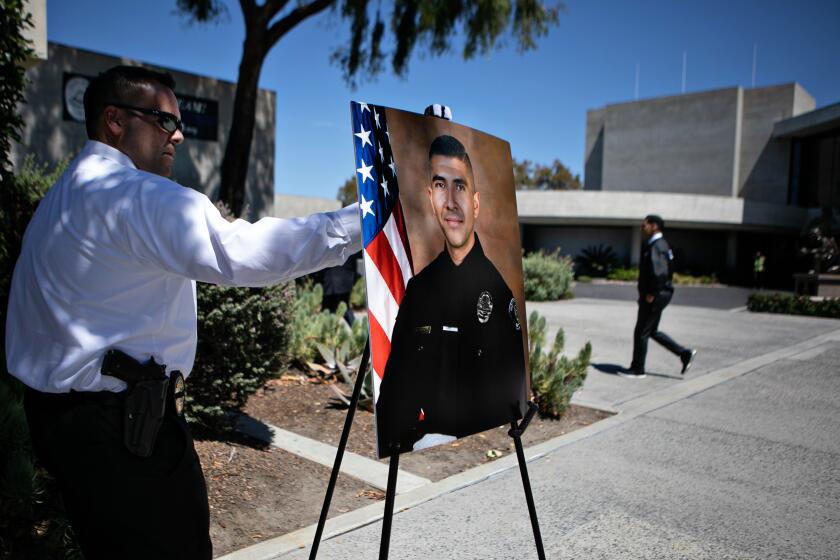How California detectives found a suspect in teen’s 40-year-old rape and killing

- Share via
Authorities in Northern California have arrested a 75-year-old Hawaii man in connection with the rape and killing of a teenager in Sunnyvale nearly 40 years ago, using forensic genealogy to zero in on the suspect from his family tree.
Gary Ramirez was arrested Aug. 2 at his home in Makawao on the island of Maui, the Santa Clara County district attorney’s office said Tuesday. Once extradited, he will be arraigned on a charge of murder with rape and kidnapping special circumstances, as well as being armed with a dangerous or deadly weapon during the commission of a felony.
Karen Stitt, 15, of Palo Alto was last seen the night of Sept. 2, 1982. She and her 17-year-old boyfriend met at a 7-Eleven shortly before 9 p.m., walked to a miniature golf course and continued on to Ponderosa Elementary School, according to a statement by Sunnyvale Det. Matthew Hutchison.
Hutchison’s statement was included with charging documents filed against Ramirez. Stitt’s then-boyfriend was not identified.
Around midnight, Stitt’s boyfriend walked her from the school back to the area near the convenience store so she could take a bus back to Palo Alto, Hutchison said.
The boyfriend “later told police that he felt bad about leaving her alone, but he did not want to get in trouble with his parents for being home late,” according to the statement.
The victim was identified as Gardiel Solorio, 26, an off-duty officer from the Monterey Park Police Department.
Around 10:45 the next morning, a truck driver discovered what he thought was a female’s nude body lying in the bushes at the base of a cinderblock retaining wall along the driveway of the Woolworth Garden Center, where he was making a delivery, Hutchison said.
Stitt’s wrists were bound behind her back with her shirt, her jacket was tied around her left ankle, and a blood stain was found on top of the cinderblock wall just above her body.
A medical examiner found that she had been stabbed 59 times in her neck, chest, abdomen and back, Hutchison said. Her cause of death was found to be “stab wounds to the chest and neck.”
Stitt’s body was found about 100 yards from the bus stop, and investigators noted that leaves and dirt around her feet were disturbed and kicked, “suggesting that she was still alive when her body was moved there,” Hutchison said.
An extensive investigation was not able to identify a suspect, and the case went cold for 20 years.
By 2000, DNA analysis technology allowed investigators to build a genetic profile of the suspect from a sample taken of the bloodstain on the cinderblock wall above Stitt, Hutchison said. Swabs taken from the scene as well as items collected from Stitt’s body were also sent to the Santa Clara County crime laboratory.
Investigators found that an unknown male’s DNA taken from the sample on the wall matched the profile for DNA found on Stitt’s jacket and from sperm cells found on vaginal slides taken during her autopsy.
A DNA sample from Stitt’s boyfriend at the time did not match, and he was excluded as a suspect, the detective said. No matches were found after comparing the unknown profile to a national DNA crime database.
Police and prosecutors are determined to access DNA information from private, consumer sites. They say the data is invaluable, but privacy advocates say the practice is ripe for abuses.
Hutchison said that in 2021, he received a tip that a male member of the Ramirez family may have killed Stitt, launching his genealogical search.
U.S. census records and other public databases showed that the family lived in Fresno, about 160 miles from Sunnyvale, as early as 1950, according to the detective’s statement.
Hutchison found that there were four living Ramirez brothers; further investigation ruled out two of the brothers, and he was not able to conclusively rule out a third, leading him to turn his focus to Gary Ramirez.
In early March, Hutchison used social media to identify Ramirez’s daughter, and he “obtained a sample” of her DNA on April 8. Court documents did not say how the detective got the sample.
Investigators found “very strong statistical support” tying DNA from Ramirez’s daughter to the unknown male DNA from the Stitt crime scene, the detective said, establishing Ramirez as the prime suspect.
More to Read
Sign up for Essential California
The most important California stories and recommendations in your inbox every morning.
You may occasionally receive promotional content from the Los Angeles Times.













